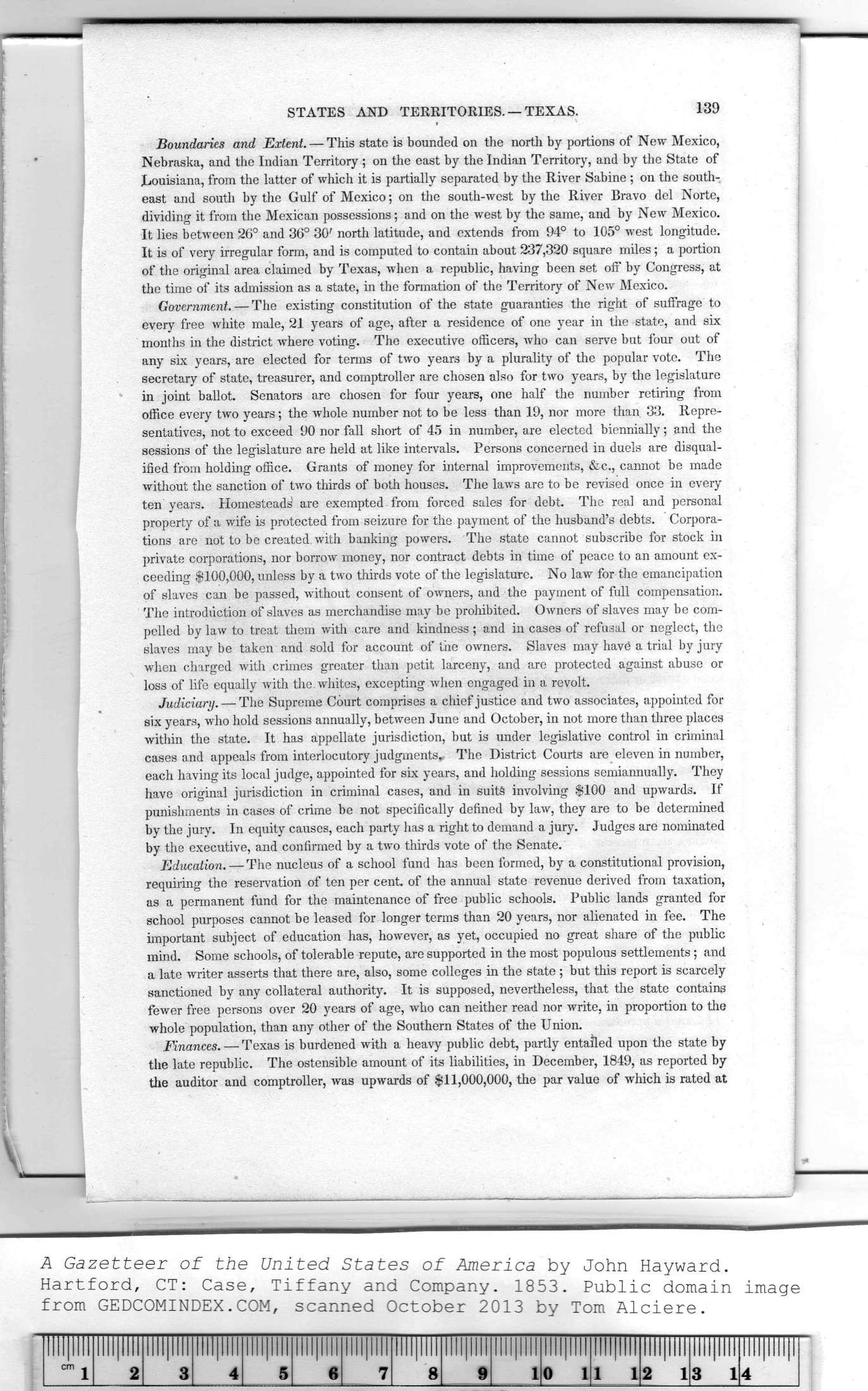|
|
Note: Ctrl and + increases the font size of the text below, Ctrl and - decreases it, and Ctrl and 0 resets it to default size.
STATES AND TERRITORIES. — TEXAS. 139
Boundaries and Extent. — This state is bounded on the north by portions of New Mexico,
Nebraska, and the Indian Territory ; on the east by the Indian Territory, and by the State of
Louisiana, from the latter of which it is partially separated by the River Sabine ; on the south-
east and south by the Gulf of Mexico; on the south-west by the River Bravo del Norte,
dividing it from the Mexican possessions; and on the west by the same, and by New Mexico.
It lies between 26° and 36° 30' north latitude, and extends from 94° to 105° west longitude.
It is of very irregular form, and is computed to contain about 237,320 square miles; a portion
of the original area claimed by Texas, when a republic, having been set off by Congress, at
the time of its admission as a state, in the formation of the Territory of New Mexico.
Government. — The existing constitution of the state guaranties the right of suffrage to
every free white male, 21 years of age, after a residence of one year in the state, and six
months in the district where voting. The executive officers, who can serve but four out of
any six years, are elected for terms of two years by a plurality of the popular vote. The
secretary of state, treasurer, and comptroller are chosen also for two years, by the legislature
in joint ballot. Senators are chosen for four years, one half the number retiring from
office every two years; the whole number not to be less than 19, nor more than 33. Repre-
sentatives, not to exceed 90 nor fall short of 45 in number, are elected biennially; and the
sessions of the legislature are held at like intervals. Persons concerned in duels are disqual-
ified from holding office. Grants of money for internal improvements, &c., cannot be made
without the sanction of two thirds of both houses. The laws are to be revised once in every
ten years. Homesteads are exempted from forced sales for debt. The real and personal
property of a wife is protected from seizure for the payment of the husband's debts. Corpora-
tions are not to be created with banking powers. The state cannot subscribe for stock in
private corporations, nor borrow money, nor contract debts in time of peace to an amount ex-
ceeding $100,000, unless by a two thirds vote of the legislature. No law for the emancipation
of slaves can be passed, without consent of owners, and the payment of full compensation.
The introduction of slaves as merchandise may be prohibited. Owners of slaves may be com-
pelled by law to treat them with care and kindness ; and in cases of refusal or neglect, the
slaves may be taken and sold for account of the owners. Slaves may have a trial by jury
when charged with crimes greater than petit larceny, and are protected against abuse or
loss of life equally with the whites, excepting when engaged in a revolt.
Judiciary. — The Supreme Court comprises a chief justice and two associates, appointed for
six years, who hold sessions annually, between June and October, in not more than three places
within the state. It has appellate jurisdiction, but is under legislative control in criminal
cases and appeals from interlocutory judgments. The District Courts are eleven in number,
each having its local judge, appointed for six years, and holding sessions semiannually. They
have original jurisdiction in criminal cases, and in suits involving $100 and upwards. If
punishments in cases of crime be not specifically defined by law, they are to be determined
by the jury. In equity causes, each party has a right to demand a jury. Judges are nominated
by the executive, and confirmed by a two thirds vote of the Senate.
Education. — The nucleus of a school fund has been formed, by a constitutional provision,
requiring the reservation of ten per cent, of the annual state revenue derived from taxation,
as a permanent fund for the maintenance of free public schools. Public lands granted for
school purposes cannot be leased for longer terms than 20 years, nor alienated in fee. The
important subject of education has, however, as yet, occupied no great share of the public
mind. Some schools, of tolerable repute, are supported in the most populous settlements ; and
a late writer asserts that there are, also, some colleges in the state ; but this report is scarcely
sanctioned by any collateral authority. It is supposed, nevertheless, that the state contains
fewer free persons over 20 years of age, who can neither read nor write, in proportion to the
whole population, than any other of the Southern States of the Union.
Finances. — Texas is burdened with a heavy public debt, partly entailed upon the state by
the late republic. The ostensible amount of its liabilities, in December, 1849, as reported by
the auditor and comptroller, was upwards of $11,000,000, the par value of which is rated at
|
lllllllll |
lllllllll |
lllllllll |
lllllllll |
llll|llll |
lllllllll |
llll|llll |
lllllllll |
lllllllll |
lllllllll |
lllllllll |
lllllllll |
lllllllll |
lllllllll |
llll|llll 1 |
|
ul 11 ^ |
2 |
3 |
4 |
5 |
6 |
7 |
8 |
9 |
1 |
0 1 |
1 1 |
2 1 |
00 |
4 |
|
